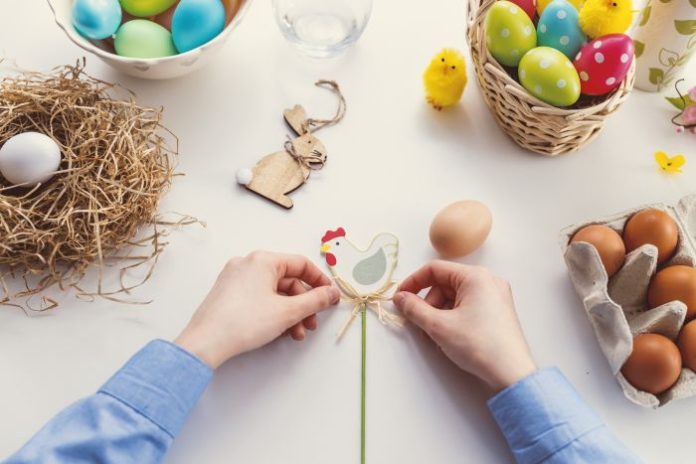
Here are the 7 WWF tips for a sustainable Easter:
1 – Do-it-yourself decorations
There is no need to buy too many decorations, we can create some with painted eggs, ribbons, paper flowers and other recycled materials. If we don’t have the colours to paint our eggs, remember that you can also make them with food and spices: turmeric for yellow, paprika for orange, red turnips for fuchsia, coffee for brown, spinach for green, red wine for purple. And above all, let’s not forget to use the insides of eggs to prepare our traditional recipes with local products.
2 – Zero km and seasonal products
Choosing zero-kilometre, local and seasonal products not only helps the local economy, which has been put to the test by the current situation, but also the environment, because it helps reduce the impact of out-of-season production and transport, which is often a burden on the wallet. Alongside this is the importance from a nutritional point of view. Nature grows food at specific times to make up for the deficiencies we face month after month. At Easter, for example, give asparagus, rich in vitamins and antioxidants, agretti and broad beans a go.
For any doubts, just consult the Seasonal Calendar on the WWF’s Ecotips page.
3 – Conscious shopping
Nowadays it is more important than ever to shop consciously, not only avoiding unnecessary packaging and excessive purchases, but also with a list in hand to buy only what is necessary, reducing waste and trips to the supermarket. Finally, it is important to pay close attention to expiry dates, so as not to buy food that will perish before it is actually used, but above all, let’s bring lots of loose and fresh produce to the Easter table, from fruit and vegetables to dairy products and eggs.
4 – What about Easter eggs?
For Easter, it is important to buy chocolate with a guarantee that it does not come from crops linked to deforestation practices: if possible, choose organic certification for chocolate or certifications that attest to compliance with environmental and social sustainability criteria such as Rainforest Alliance, or Fairtrade. To make good chocolate, you need good cocoa. And cocoa is really good if it is produced with respect for nature, biodiversity, workers and the health of all.
5 – Freezing or creatively reusing leftover food
Freezing food in the freezer is a convenient and easy way to keep a lot of food in good condition for longer, avoiding waste. Freezing is essential when, for example, we want to preserve seasonal products (such as mushrooms) to have them available even in the months when they are not in season, or when we want to stock up. When freezing we use reusable containers (suitable for food contact and use in the freezer) as much as possible instead of disposable bags, sheets and film. Remember to write down the date and contents of our containers so that we have an overview of our stock. If we have lots of leftovers and the freezer is full, then give free rein to creativity: a savoury pie such as the classic pasqualina, for example, can be cut into cubes, reheated and served as an aperitif during Easter Monday lunch.
6 – Learn to read labels to avoid waste
As well as being environmentally unsustainable, food waste represents an economic loss for families. Yet all this waste can be drastically reduced by learning to recognise the difference between the ‘best before’ date – ‘best before’ and therefore not beyond that date because it can be hazardous to health – and ‘best before’, which means that the food will be safe to eat even after the date on the label (provided the packaging is intact), but may not be in the best condition. For example, the taste and texture may not be the best. In addition to expiry dates, it is also important to remember how important it is to store food well: if we store it well it will give us plenty of time to eat it.
7- Where do I throw it away?
Often the disposal of typical festive objects and products can be complicated or unknown. For example: not everyone knows that for dove packaging, the outer box is disposed of in paper, the inner transparent plastic bag in plastic, while the baking mould, if it has food residues and is compostable, is disposed of in organic waste. If it has food residues and is not compostable, it goes in the general waste bin. Also go there: used candles, mussel and clam shells (unless your municipality indicates otherwise), shiny or silver Easter egg wrappers, coloured paper napkins and imitation corks from wine and sparkling wine. WWF’s advice tends both to reduce the consumption of disposable materials as much as possible, proposing reusable alternatives (for example, off-the-shelf tableware is in fashion), and to encourage the purchase of items in bulk or with reduced packaging, avoiding overpackaging. A general rule that applies to plastic, glass and metal is that only packaging should be recycled. Plastic, glass and metal objects that are not packaging should be recycled, e.g. toys, a glass or a metal plate. Another important rule is to “reduce the volume” of waste, i.e. to crush the packaging before putting it in the recycling bin. For bottles, for example, the side surface of the bottle should be flattened rather than crushed from the cap to the bottom, to facilitate identification during recycling.







































